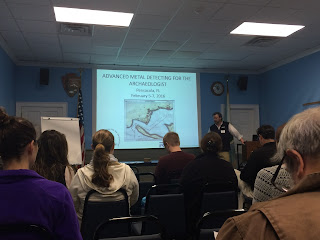Metal Detecting and Archaeology
Metal detectors can be a great tool to help archaeologists identify metal artifacts, especially at sites like battlefields where artifacts are small and widely distributed. Doug Scott was one of the first archaeologists who used metal detecting at the Battle of Little Bighorn. He used these tools along with archaeological survey methods (especially mapping and spatial patterning!) and forensic methods (like figuring out bullet trajectories) to understand how the battle unfolded. This method has been repeated at many other battlefields very successfully.
So I was very excited to attended the Advanced Metal Detecting Training for the Archaeologist training, offered through the Register of Professional Archaeologists and taught in part by Doug Scott! Over three days, we learned how to use metal detectors and even completed a small survey near Fort Pickens at Gulf Islands National Seashore.
We spent the first day in the classroom, learning how metal detectors can be used on various projects, how to set up and document surveys and the basics of the equipment. Did you know the first metal detector was invented by Alexander Graham Bell? He was asked to use it after President Garfield was shot in order to find the bullet more quickly and efficiently. However the detector couldn't seem to locate the bullet, as it kept going off whenever it got near the President. No one had warned Bell that President Garfield was lying on a new metal coil spring mattress!
Metal detectors work by sending a electromagnetic wave into the earth that responds to anything magnetic within range. Some models can discriminate between types of metals while in the ground. The machine's depth range can vary but many range between 10-30 centimeters. You can even get an underwater metal detector to help in excavating sites like shipwrecks!
To practice and hone our new skills, we were able to do a small survey of an area hoped to be associated with a Civil War battle near Fort Pickens. Our first step was to understand the background and history of the site, which included a great tour of the Fort by the Park Historian. During the Battle of Santa Rosa Island, Confederate troops attacked a group of Union soldiers who were camped outside of the fort in efforts to capture the Fort. The Confederates were unsuccessful and soon retreated, but not before burning the camp and taking a few casualties.
Our small survey did find evidence of this Civil War camp, including buttons, ammunition and other related military items. We found a large hunk of melted lead that could have been a melted box of ammunition, which speaks very much to the tale of a burning camp. And of course, we also found lots of more recent finds including pop-tops, more recent gun shells and various bits of metal trash.
For more on metal detecting, including case studies and a few notes on laws and ethics, check out Time Team America's blog on the topic.
Text by Emily Jane Murray, FPAN Staff
So I was very excited to attended the Advanced Metal Detecting Training for the Archaeologist training, offered through the Register of Professional Archaeologists and taught in part by Doug Scott! Over three days, we learned how to use metal detectors and even completed a small survey near Fort Pickens at Gulf Islands National Seashore.
We spent the first day in the classroom, learning how metal detectors can be used on various projects, how to set up and document surveys and the basics of the equipment. Did you know the first metal detector was invented by Alexander Graham Bell? He was asked to use it after President Garfield was shot in order to find the bullet more quickly and efficiently. However the detector couldn't seem to locate the bullet, as it kept going off whenever it got near the President. No one had warned Bell that President Garfield was lying on a new metal coil spring mattress!
Metal detectors work by sending a electromagnetic wave into the earth that responds to anything magnetic within range. Some models can discriminate between types of metals while in the ground. The machine's depth range can vary but many range between 10-30 centimeters. You can even get an underwater metal detector to help in excavating sites like shipwrecks!
 |
| Metal detecting is no joke: we spent a whole day learning the basics before we even picked up the equipment. |
To practice and hone our new skills, we were able to do a small survey of an area hoped to be associated with a Civil War battle near Fort Pickens. Our first step was to understand the background and history of the site, which included a great tour of the Fort by the Park Historian. During the Battle of Santa Rosa Island, Confederate troops attacked a group of Union soldiers who were camped outside of the fort in efforts to capture the Fort. The Confederates were unsuccessful and soon retreated, but not before burning the camp and taking a few casualties.
 |
| Understanding the history of the site is step one to any survey. |
 |
| The FPAN Crew and Lauren Walls, AMDA instructor, with metal detector find. Photo Credit: Doug Scott. |
Text by Emily Jane Murray, FPAN Staff